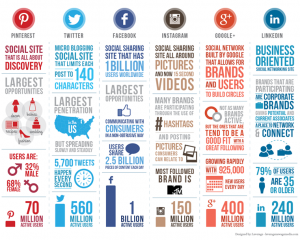The idea of a work-life balance isn’t a new concept (but if you’ve never heard of it, check out this awesome TED Talk). It’s the age-old question that every worker asks at some point in their career: how do I balance the demands of my personal life with the demands of my professional life?

In this day and age, that question becomes harder to answer with the omnipresence of social media. We document almost every part of our lives online: posting every #tbt, latergram, and newly relevant Buzzfeed article is second nature to us. But how does this constant connectivity lend itself to the workplace?
With Facebook, Twitter, and Instagram having over 1.8 billion combined users, the line between what internet activity is strictly personal and what could have professional consequences is getting blurrier and blurrier. Everything you post has the potential to be seen by future and current employers—cat memes and party pics alike. So as we all prepare to enter the working world, the new work-life question we need to keep in mind is: how do I maintain my active online presence and still be a professional?

Quad co-founder Lauren Hockenson (CAS & COM ’11) is a verified master of social media. As a current reporter for technology blog GigaOM with over 3,000 followers on Twitter, Hockenson has created a name for herself as a go-to source for technology news and overall interesting information.
With great power comes great responsibility, however. Because being active online is such a crucial part of her job, Hockenson is especially attentive to how she conducts herself on the internet. She abides by what she calls her “personal brand”—the image of herself that she wants to project to people. As a result, she has made her brand a perfect blend of personal and professional.
For Hockenson, her “brand” is ultimately about her know-how.
“People follow me for business and tech news on Twitter, and it’s important to them and to keeping my follower count that I do that for them,” she says. “I talk about relevant tech news and tweet about funny things. I try to keep it very journalism, technology, and business-centric. But I also try to be a personality, not a robot. I try to keep it fresh and relevant. And that’s my personal brand. But everyone’s personal brand is different.”
Regardless of what your brand is, Hockenson stresses the importance of watching what you post.
“You can lose your job or not get a job based on what you put online,” she says. “[Posting online] is not like screaming into a vacuum—people can hear you!”
With that in mind, it’s crucial to remember that venting online is never in good taste, especially when it’s about your job. No matter how frustrating your boss or coworkers may be, slamming them on social media only looks bad on your part:
“Subtweeting your boss is a bad idea,” Hockenson states emphatically. “Don’t do it. Don’t subtweet your manager, don’t subtweet your coworker. Don’t bring that energy into your personal brand. Because somebody’s going to find it. That’s the kind of stuff employers are going to see and say, no, I don’t want someone who’s going to spend their day on social media grousing about their job.”
Ultimately, it’s about making your brand reflect exactly what you want it to. “Post about the things that you want to be known for—present yourself how you want to be presented,” Hockenson says. Because employers will look you up on social media, you want to make sure that your timelines and tweet decks are at least relatively clean. “I mean, I don’t expect that someone is going to scroll through my 5,065 tweets to find something to incriminate me. But at the same time, I’m never going to say something that’s going to cost me.”

The story of ex-PR executive Justine Sacco is a testimony to the importance of minding your manners online.
Sacco, then Head of Communications at media giant InterActiveCorp (IAC), was about to leave for a vacation in South Africa when she tweeted, “Going to Africa. Hope I don’t get AIDS. Just kidding! I’m white.”
Within minutes, the tweet went viral. The hashtag #HasJustineLandedYet was created with tweeters accusing her of racism and sending her death threats. Sacco, who was midflight and unable to access the internet, was completely oblivious to the havoc her tweet was causing. Of the incident, IAC issued the following statement:
“This is an outrageous, offensive comment that does not reflect the views and values of IAC. Unfortunately, the employee in question is unreachable on an international flight, but this is a very serious matter and we are taking appropriate action.”
Of course, Sacco was fired upon her arrival in Cape Town.
Sacco’s story reinforces the idea that a reputation can be destroyed in a matter of minutes, especially online. With the internet, the things we say and do can travel farther than we could ever imagine. No matter how innocuous something may seem, it can easily come back to bite you.
Hockenson thinks of it this way: “Imagine that you’re at a party and you don’t know anyone and you want to make friends with someone. Would you go up to them and make a joke about AIDS? No. So I think about my brand as a party—I want to say witty, intelligent, interesting things. And make a couple of awesome jokes.“

As damaging as social media can be to a professional reputation, it can also be helpful. Professional networking sites like LinkedIn are increasingly becoming a method of interaction between professionals and those looking to get hired.
Joyce Greenwood Rogers is the Director of Career Services in the College of Communication. In addition to managing the Career Services office, Rogers counsels students about every aspect of job searching, online presence included. According to Rogers, knowing how to use social media is crucial.”When we hire people for the office, the first thing I’m looking for is people with outstanding computer and social media skills,” she says.
It’s also crucial to be on certain social media sites. According to Rogers, having a LinkedIn account is integral to getting hired. It’s part digital resume and part networking event; it allows you to showcase your skills and experiences, and then connects you with professionals who are looking for people like you. “If you’re looking for a job or an internship, [LinkedIn] is actually essential,” she says.
But LinkedIn isn’t the only site for professionals. Even Google+ can be used for networking. With its Circles feature, you can create a space strictly for interacting with businesses and colleagues. With its Drive feature, it’s great for collaborating on projects.
But even with professional networking sites, you have to be careful with what you post. Only post content that is relevant to your audience; potential employers would much rather see examples of your past work than pictures of your last vacation. Also be sure to post thoughtfully. “Watch your settings, make sure you know who’s able to look at what,” says Rogers. “And don’t put anything on there that you’re going to regret 10 years from now. If you need to tell somebody something, find another way to do it!”
These days, social media is inescapable. It’s how we interact with the world around us; uploading a Vine, pinning a recipe on Pinterest, and adding a presentation to LinkedIn all serve to communicate who we are as people. But because we use social media in both personal and professional contexts, it can be tricky to differentiate what information falls into what category. Not only that, but it can be difficult to separate our personal identity from our professional one, which can lead to trouble in the working world.
In the end, finding a balance between personal and professional internet activity depends on how much information you want people to have about you. It requires being aware of your searchability and realizing that once you post something online, it never goes away. Luckily, you do have authority over how you appear online. Your personal brand is in your hands.
But to Rogers, finding that balance is the least of our worries. “I think everybody’s going to have to judge how to find that balance because it depends on how much social media you have to use in your job and how much you want to use in your life. But I advise young people that life is not social media, you should have a life outside of that,” she says. With a shake of her head she adds, “Sometimes I get concerned that there’s not enough real interaction between young people these days.”



